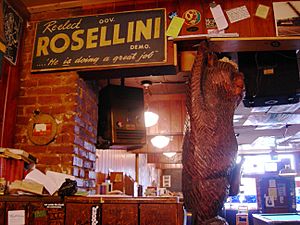Blue Moon Tavern facts for kids

A poster for Albert Rosellini's successful 1960 re-election campaign on display inside the Blue Moon
|
|
| Private | |
| Industry | Food and beverage |
| Founded | April 1934 |
| Headquarters |
,
U.S.
|
|
Area served
|
University District |
The Blue Moon is a historic gathering place located in the University District in Seattle, Washington, United States. It first opened in April 1934. This was just four months after a time called Prohibition ended. During Prohibition, it was against the law to make or sell alcoholic drinks. The Blue Moon has been a popular spot for many famous writers and artists over the years.
Contents
The Blue Moon: A Historic Seattle Spot
The Blue Moon is known as the first and oldest gathering place of its kind in Seattle's University District, often called the U-District. When it opened, it quickly became a favorite for students. Another popular spot, the Duchess Tavern in Ravenna, opened the same year. Back then, students had to travel about a mile from the campus to buy drinks.
During World War II, the Blue Moon was one of the few places outside of Seattle's Central District that welcomed African American servicemen. This made it a special and important place for many.
A Hub for Writers and Artists
The Blue Moon also became a safe place for professors from the University of Washington. This was during a time called McCarthyism. Some professors, like Joe Butterworth, were unfairly accused of certain beliefs and lost their jobs. The Blue Moon offered them a place to meet and even work.
The 1950s and 1960s were a very popular time for the Blue Moon. Many famous people visited regularly. These included authors like Tom Robbins and Darrell Bob Houston. Poets such as Theodore Roethke, Richard Hugo, Carolyn Kizer, Stanley Kunitz, and David Wagoner also spent time there. Painters like Richard Gilkey and Leo Kenney were regulars too. Other well-known visitors included Dylan Thomas, Ken Kesey, Allen Ginsberg, and Mik Moore.
There's a fun story about Tom Robbins. It's said that in the late 1960s, he tried to call the famous artist Pablo Picasso in Barcelona from a pay phone at the Blue Moon. The story goes that Robbins actually reached Picasso, but Picasso didn't want to pay for the international call!
Protecting a Piece of History
The Blue Moon became less popular in the 1970s. In 1989, there were plans to change the building. But community groups, led by Walt Crowley, worked hard to stop these plans. They wanted to protect the Blue Moon.
In 1990, there was an attempt to give the Blue Moon "landmark status." This means officially recognizing a building as historically important to protect it. Even though this attempt didn't succeed, the developers decided not to tear down the tavern. The Blue Moon is now one of the few old, working-class landmarks left in Seattle.
In 1995, the alley next to the Blue Moon was named Roethke Mews. This was done to honor Theodore Roethke, one of the bar's famous poet visitors.
Images for kids
-
A poster for Albert Rosellini's successful 1960 re-election campaign on display inside the Blue Moon



